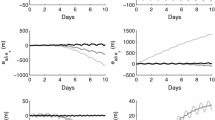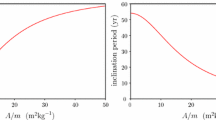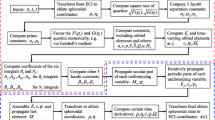Abstract
In this paper we consider the relative motion between satellites moving along near circular orbits in LEO. We are focussing upon the natural dynamics in order that we may then develop a design tool for choosing initial conditions for satellite orbits where the satellites will follow close to a chosen configuration with little control. The approach presented here is different to much of the other published work on this topic in that we start with analytic solutions of the absolute equations of motion rather than attempt to develop linearised equations of relative motion which we then solve. This geometric approach leads to a natural decomposition of the orbital motion into three components: the motion of a guiding centre that incorporates the secular evolution of the formation due to the even zonal harmonics; the periodic motion of the formation as an approximately solid body about this guiding centre; and the periodic motion of individual satellites within the formation. By separating the motion into these three components we are able to give a full description of the motion, but in a simple form avoiding much of the complexity in other formulations. We then use this model to find expressions for the motion of one satellite with respect to another within our formation. We present propagations of satellite orbits to fully evaluate the accuracy of our expressions, noting additions that may be made to the model to further increase accuracy.
Similar content being viewed by others
References
Bond V.R. (1999). A new solution for the rendezvous problem. Adv. Astronaut. Sci. 102(2): 1115–1143
Clohessy, W.H., Wiltshire, R.S.: Terminal guidance system for satellite rendezvous. J. Aerospace Sci. 27(9), 653–658, 674 (1960)
Gill E. and Runge H. (2004). Tight formation flying for an along-track SAR interferometer. Acta Astronaut. 55(3–9): 473–485
Gim D.-W. and Alfriend K.T. (2003). State transition matrix of relative motion for the perturbed non-circular reference orbit. J. Guidance, Control Dyn. 26(6): 956–971
Gim D.-W. and Alfriend K.T. (2005). Satellite relative motion using differential equinoctial elements. Celest. Mech. Dyn. Astron. 92: 295–336
Halsall, M., Palmer, P.L.: An analytic relative orbit model incorporating J 3. AIAA/AAS Astrodynamics Specialist Conference and Exhibit, Keystone, Colorado, 21–24 August 2006
Hametz, M.E., Conway, D.J., Richon, K.: Design of a formation of earth orbiting satellites: The Auroral Lites Mission. In: Proceedings of the 1999 NASA/GSFC Flight Mechanics Symposium, Greenbelt, Maryland, May 1999
Hashida, Y., Palmer, P.: Epicyclic motion of satellites about an oblate planet. J. Guidance, Control Dyn. 24(3), 586–596, 674 (2001)
Hashida Y. and Palmer P. (2002). Epicyclic motion of satellites under rotating potential. J. Guidance, Control Dyn. 25(3): 571–581
Inalhan, G., How, J.P.: Relative dynamics and control of spacecraft formations in eccentric orbits. AIAA Guidance, Navigation and Control Exhibit, Denver, Colorado, August 2000
Karlgaard C.D. and Lutze F.H. (2004). Second-order equations for rendezvous in a circular orbit. J. Guidance, Control Dyn. 27(3): 499–501
Karlgaard C.D. and Lutze F.H. (2003). Second-order relative motion equations. J. Guidance, Control Dyn. 26(1): 41–49
Kormos, T.: Dynamics and Control of Satellite Constellations and Formations in Low Earth Orbit. Ph.D. thesis, University of Surrey (2004)
Melton R.G. (2000). Time-explicit representation of relative motion between elliptical orbits. J. Guidance, Control Dyn. 23(4): 604–610
Mishne D. (2004). Formation control of satellites subject to drag variations and J2 perturbations. J. Guidance, Control Dyn. 27(4): 685–692
Moccia A., Vetrella S. and Bertoni R. (2000). Mission analysis and design of a bistatic synthetic aperture radar on board a small satellite. Acta Astronautica 47(11): 819–829
Schaub H. (2004). Relative orbit geometry through classical orbit element differences. J. Guidance, Control, Dyn. 27(5): 839–848
Schaub H. and Alfriend K.T. (2001). J 2 invariant relative orbits for spacecraft formations. Celest. Mech. Dyn. Astron. 79: 77–95
Schweighart S.A. and Sedwick R.J. (2002). High-fidelity linearized J 2 model for satellite formation flight. J. Guidance, Control Dyn. 25(6): 1073–1080
Vadali, S.R.: An Analytical Solution for Relative Motion of Satellites. 5th Dynamics and Control of Systems and Structures in Space Conference, Cranfield University, Cranfield, UK (2002)
Vaddi S.S., Vadali S.R. and Alfriend K.T. (2003). Formation flying: accommodating nonlinearity and eccentricity perturbations. J. Guidance, Control Dyn. 26(2): 214–223
Wnuk E. and Golebiewska J. (2005). The relative motion of earth orbiting satellites. Celest. Mech. Dyn. Astron. 91: 373–389
Wnuk, E., Golebiewska, J.: Differential perturbations and semimajor axis estimation for satellite formation orbits. AIAA/AAS Astrodynamics Specialist Conference and Exhibit, Keystone, Colorado, 21–24 August 2006
Author information
Authors and Affiliations
Corresponding author
Rights and permissions
About this article
Cite this article
Halsall, M., Palmer, P.L. Modelling natural formations of LEO satellites. Celestial Mech Dyn Astr 99, 105–127 (2007). https://doi.org/10.1007/s10569-007-9084-7
Received:
Revised:
Accepted:
Published:
Issue Date:
DOI: https://doi.org/10.1007/s10569-007-9084-7




